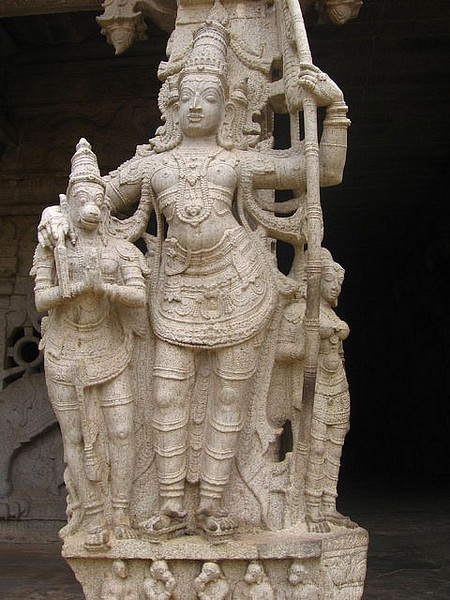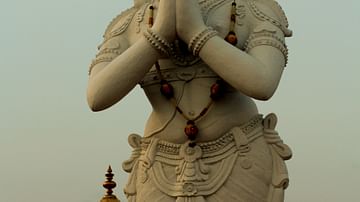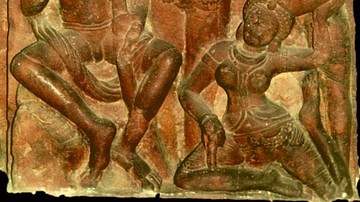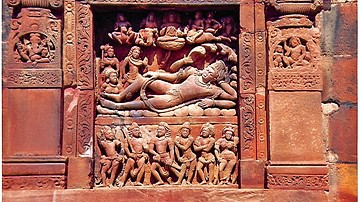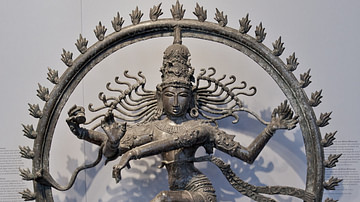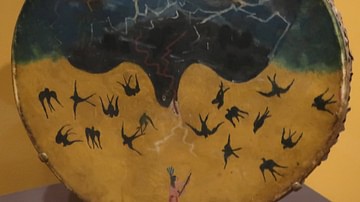
Ravana is the mythical multi-headed demon-king of Lanka in Hindu mythology. With ten heads and twenty arms, Ravana could change into any form he wished. Representing the very essence of evil, he famously fought and ultimately lost a series of epic battles against the hero Rama, seventh avatar of Vishnu.
Family
Ravana was a terrible demon (raksasa) who was the king of all demons and of the fortress island of Lanka (modern-day Sri Lanka). His father was Visravas (son of Pulastya, one of the creator Prajapati) and his mother Nikasa, also a demon and mother of the cannibal demons, the Pisitasanas. Ravana acquired his throne through foul means when he expelled his half-brother Kubera, god of wealth, from the island. Ravana had many sons, notably Aksa, who had three heads, symbolic of the three stages of fever (heat, cold, and sweating), and Indrajit (aka Meghanada), who could make himself invisible.
Ravana had a formidable appearance with his ten heads (and so he is also known as Dasakantha and Panktigriva) and twenty arms. His body was covered in scars, won in endless battles with the gods. Three wounds, in particular, were from the discus of Vishnu, the thunderbolt of Indra, and the tusk of Airavata, the elephant of Indra. Through his devotion and penance to the great god Brahma, Ravana was made invincible and had the power to assume any form he wished, from men to mountains to death itself. He was so powerful that he could cause earthquakes and storms. However, it was foretold that Ravana's end would come because of a woman, and so it would be.
Ravana & Nandisa
The Ramayana is the oldest Sanskrit epic and was written sometime in the 5th century BCE, with some later additions. Ravana's name is explained, therein, in a colourful myth where the demon-king challenges Nandisa (actually the great god Shiva and also known as Nandisvara) and comes off worse. According to the story, one day Ravana met a dark dwarf with a monkey face while he was passing through the mountains of Saravana. The dwarf would not let Ravana pass because his master Shiva was busy hunting there and was not to be disturbed. Ravana questioned who this Shiva was and shook the mountain in rage. This disturbed Shiva and his wife Parvati; the latter trembled with fear as they sat upon the shaking peak, but Shiva calmly placed his toe upon the ground and the whole mountain fell on top of Ravana's many arms. The demon let out such a shuddering cry of pain that Shiva named the demon Ravana after his cry (rava). Ravana was only released from his predicament after 1,000 years of pleading to the great god.
Rama & Surpanakha
The Ramayana is really concerned with the story of the semi-divine Lord Rama, believed by many Hindus to be based on a historical figure. He is perhaps the most virtuous figure in all of Hindu mythology. His adventures illustrate above all the importance and rewards of fulfilling one's pious duty or dharma, and he had been born for one specific task – to answer the call of the gods and kill the fearsome multi-headed demon Ravana, terror of the earth.
Rama's troubles began when he was exiled from his father's kingdom, a victim of a conspiracy concocted by his mother's jealous hunchback slave, Manthara. On top of that, his brother Bharata was made heir in Rama's place. For 14 years, Rama had to wander the earth, visit sages, and wait to fulfil his destiny.
Rama, his wife Sita, and great friend Laksmana one day eventually ended up at Pancavati along the river Godavari, an area plagued by demons. One in particular, Surpanakha, the sister of Ravana, fell in love with Rama, and when her advances were resisted, she attacked Sita in revenge. Laksmana was the first to react and cut off the ears and nose of Surpanakha. Not best pleased with this treatment, the enraged demoness gathered an army of demons to attack the trio. In an epic battle, Rama defeated them all; however, Surpanakha was not finished with the matter, and she persuaded Ravana that Sita was a girl worth fighting for. Accordingly, the demon king sought out Rama's home, and while Rama was distracted in the hunt for a deer (who was actually Ravana's magician Maricha in disguise), abducted Sita, taking her back to Lanka in his aerial chariot to be kept captive in the beautiful Ashoka garden of his palace.
Ravana Battles Rama
Rama followed in hot pursuit. First he had to fight the monster Kabandha and assist the monkey king Sugriva, but as a reward for the latter, he gained the invaluable help of Sugriva's general Hanuman and his army. Hanuman was also the son of the wind and able to leap huge distances, taking any form he wished. It was he who magically transported Rama and his force to Lanka, crossing the rock bridge built by the skilled general Nala, which became known as Rama's Bridge.
A series of titanic battles between Rama's forces and the demons followed, sometimes Ravana got the upper hand, at other times Rama. In one fight, Rama managed to cut off one of Ravana's heads with an arrow but another immediately grew to replace it. Finally, another of Rama's arrows was a direct hit on Ravana's chest. The arrow went straight through the demon, travelled over the seas and came straight back into Rama's quiver. Ravana was dead and the world rid of a terrible lawless force. Having been the son of a brahmana (priest), Ravana was given a proper funeral and his body burnt according to correct ritual. Lanka had, meanwhile, fallen to Rama's army, and the hero headed back home to reclaim his throne and begin a golden era of government.
Ravana in Hindu Art
Ravana is usually depicted as multi-headed and multi-armed, carrying all manner of lethal weapons. He appears in the decorative sculpture of Hindu temples, most often in battle scenes with Rama or riding his winged chariot. In a celebrated relief scene on the 8th-century CE Kailasanatha temple at Ellora, Ravana is shown shaking the sacred Kailasa mountain (as in the Nandisa story) on which sit Shiva and Parvati. Unusually, Ravana is carved completely in the round. Scenes from the Ramayana involving Ravana were also very popular from the 16th century CE in Indian watercolours, especially esteemed are those from Udaipur and the Pahari paintings.
